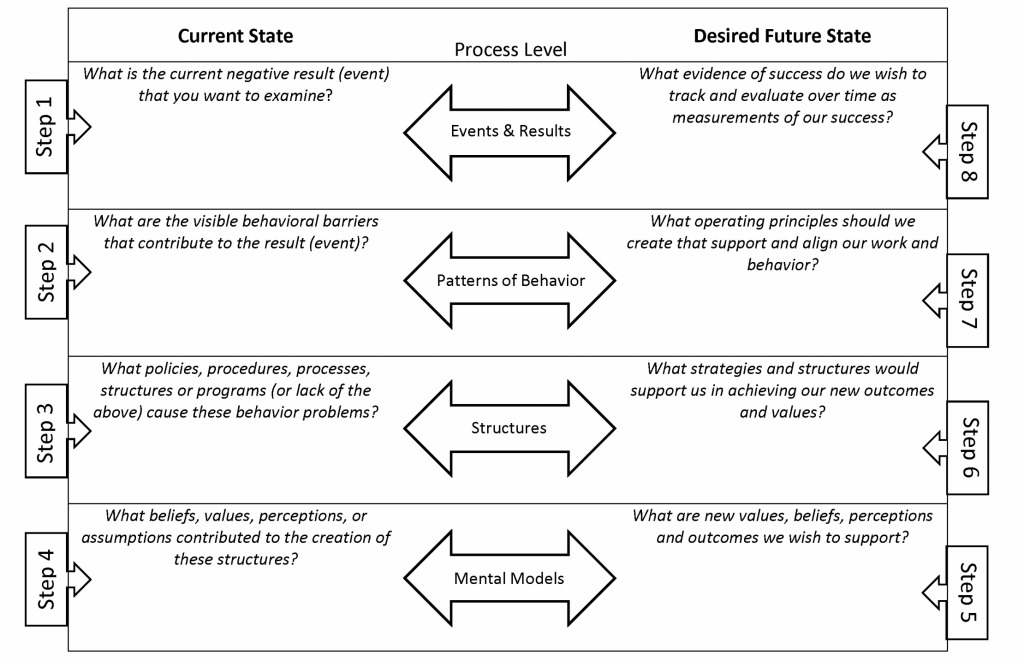ESSENTIAL FUNCTION 1: FOCUS ON IMPACT
Focusing on Impact: Operationalizing the Iceberg Framework
Chris Argyris and Donald Schon developed the Mental Models Process (Senge, 1990) which utilizes the levels of the Iceberg Framework as the context for group planning. It was designed to challenge the status quo by questioning underlying values, behaviors, and strategies. In the following video, Steven Zuieback explains how the strategy works.
The Mental Models Process (6:45 min)
Mental Models Process
Now that you have some background with the Iceberg Framework and the Mental Models Process, read through the article Planning Conversations: Mental Models Process (Zuieback, (n.d.)). As you review the diagram below, reflect on the following questions.
- What additional information about the Mental Models Process did you learn?
- For what situations and groups would this process be most powerful?
- What tips does the article provide for using this process with groups?
Mental Models Process – adapted from Zuieback (Zuieback, (n.d.)).

Systems Thinking Keeps the Focus on Impact
A Systems Thinking approach ensures there is alignment between a district’s continuous improvement efforts and other initiatives in the district. DESE has outlined 5 Pillars districts should focus on to support educators in implementing effective, evidence-based practices with the goal of “improved student learning for every student in every school.”
Leadership
Leadership
Strong leaders set the vision and influence direction at every level of the organization to create and support a culture of teaching and learning for continuous improvement.
Collaborative Climate and Culture
Collaborative Climate and Culture
Shared values and common goals are the foundation of a collaborative climate and culture of systemic growth and improvement within an educational system.
Effective Teaching and Learning
Effective Teaching and Learning
Effective academic, behavioral, and social skill practices, supported by research and meeting the needs of each student, lead to the highest levels of student learning.
Data-Based Decision Making
Data-Based Decision Making
Accurate, relevant measures across multiple points in time provide the basis for informing on progress, setting goals, and guiding decisions leading to improved student learning.
Alignment of Standards, Curriculum, and Assessment
Alignment of Standards, Curriculum, and Assessment
Connection, clarity, and coherence must exist between standards, curriculum, and assessments in order to provide accurate and actionable information regarding student learning.
Schools and districts that use a continuous improvement framework can achieve impressive results. A district’s commitment to ongoing improvement efforts that are evidence based, aligned across initiatives, and contextualized to their system can not only improve their efficiency and effectiveness, but most importantly student outcomes. Educational leaders have the responsibility for working with and supporting teams in continuous improvement. A strong improvement plan uses a systems thinking approach to narrow down goals and align initiatives, so that the plan is clear, measurable, actionable, and feasible.
However, this in only part of the process. To achieve exceptional outcomes for all students, districts must collect and analyze data to inform their District Continuous Improvement efforts. Using a data-based decision making process shifts the work of school leadership teams from reactive to pro-active. Common goals and data allow districts to look at implementation from the district level, the building level, and even the classroom level to identify successes as well as areas where further support is needed.
In the following video, Jeff Edmondson talks about the impact of data.
The Key to Educational Improvement: Data and How We Use It (TEDx Talks, 2010). (6:33 min)
Reflective Questions
How is data currently used in your building/district?
Do you have the data you need to make the decisions necessary to support every child in your system?
Do the people who need to use the data have access to it?
What would it take to make data more accessible and meaningful in your district?
For more information on Data-Based Decision Making, see the Data-Based Decision Making Module.


